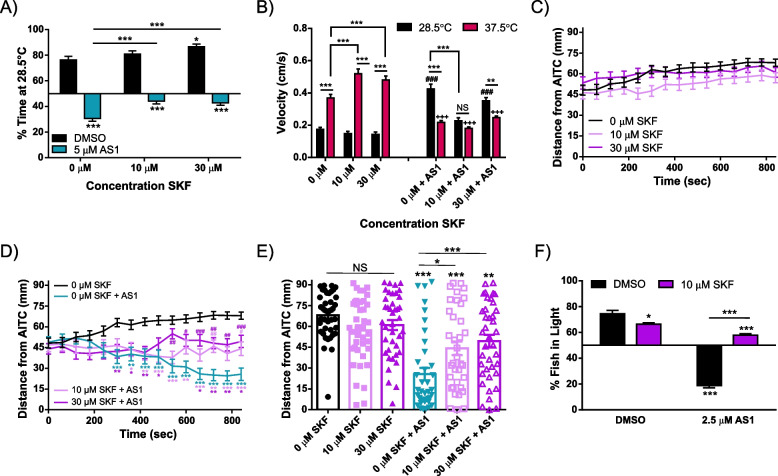Fig. 10
The D1 receptor agonist SKF82958 partially reverses AS1-induced attraction to noxious stimuli. A Temperature choice assay (28.5 °C vs 37.5 °C) with various concentrations of SKF82958. DMSO or SKF alone treated fish demonstrated significant preference for the 28.5 °C side of the arena, with the highest concentration of SKF tested eliciting a slight potentiation of preference for the 28.5 °C side. While all AS1-treated fish still preferred the 37.5 °C side of the arena regardless of whether SKF was also present, application of both 10 and 30 μM SKF did induce a significant decrease in the proportion of time fish spent in the 37.5 °C half of the arena. N = 53 fish for the DMSO condition, 53 for 10 μM SKF, 54 for 30 μM SKF, 61 for 5 μM AS1, 60 for 10 μM SKF + 5 μM AS1, and 60 for 30 μM SKF + 5 μM AS1. B Swimming velocity from the experiment shown in A. While AS1 treatment still reverses velocity patterns observed in the 37.5 and 28.5 °C zones, co-incubation with SKF partially attenuates this effect. At 10 μM SKF, the difference between swimming velocity in both zones is insignificant, and the swimming velocity at 28.5 °C is no different than that of vehicle-treated control fish. * denotes significant differences in swimming velocities between the 28.5 and 37.5 °C zones for the same group of fish, + denotes significant difference from the 0 μM AS1 37.5 °C swimming velocity, and # denotes significant difference from the 0 μM AS1 28.5 °C swimming velocity. C, D AITC aversion assay. SKF alone does not elicit any large changes in avoidance of the noxious AITC stimulus, but does partially reverse AS1-induced attraction towards AITC. N = 40 fish for the DMSO condition, 40 for the 10 μM SKF, 40 for the 30 μM SKF, 38 for 2.5 μM AS1, 36 for 10 μM SKF + 2.5 μM AS1, and 39 for 30 μM SKF + 2.5 μM AS1. * represent the significant difference of experimental traces from the DMSO-treated control fish at each indicated time point. # represent the significant difference of experimental traces compared to AS1-only control fish at the indicated time points. E Distance of each individual larva from the AITC source at the final time point (840 s) for the experiment shown in C, D. While AS1-treated fish cluster near the AITC source, fish co-incubated in SKF exhibit greater dispersal across the arena by the end of the experiment. * presented directly over columns represent the significant difference between the DMSO-only control condition, and between other columns when indicated by lines. F Phototaxis assay. While 10 μM SKF did elicit a slight decrease in the proportion of fish found in the light by itself, these fish still significantly preferred the light side, as did the vehicle-treated fish. AS1-only treated fish significantly preferred the dark half of the arena, but concurrent treatment with 10 μM SKF restored preference for the light side. N = 40 for all conditions. */#/+ p < 0.05, **/##/++ p < 0.01, ***/###/+++ p < 0.001. Two-way ANOVA with Tukey’s multiple comparisons test used in A–D, F. One-way ANOVA with Tukey’s multiple comparisons test used in E. For all temperature and light/dark choice experiments, a one-sample t test was performed with a hypothetical mean of 50% to determine if fish were significantly choosing one side of the arena over the other

